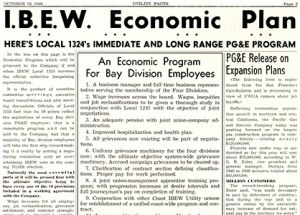The IBEW wanted a quick ruling from the NLRB on its election petition, but PG&E and UWUA sought delays. Throughout 1949 Weakley and his cohorts waited for an answer.
In October, Utility Facts published an “Economic Program” that, by implication, showed where the UWUA had fallen short. The IBEW promised an aggressive campaign for, among other things:
- Wage increases across the board
- A study of wage inequities
- An adequate pension with joint administration
- Improved hospitalization
- Uniform grievance machinery for the entire system
- A joint apprentice training program
- Improved arbitration machinery
- Complete organization of clerical workers
- A joint job bidding committee to determine job awards
It was a manifesto that detailed all the hopes that were wrapped up in the slogan “one union on the system.”
Finally, on November 29, the NLRB ordered an immediate election for Physical employees and rejected the company’s bid to exclude 51 classifications from the bargaining unit. Even so-called professional and technical employees were included, although Clerical employees were not. The NLRB rejected pleas from the company and from the UWUA to break down the bargaining units by division: it would be one election on the whole system.
It was the largest utility union election in U.S. history, with 100 polling places. Fifty NLRB officials were brought in from all over the West to handle logistics. On January 25, 1950 the results were announced:
IBEW: 6749
UWUA: 2550
Neither union: 241
Challenged ballots: 266
